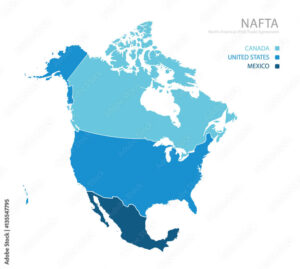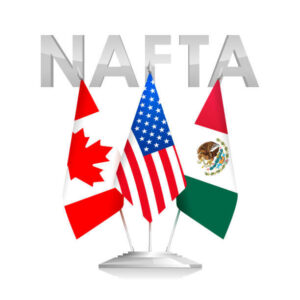Welcome to a journey into the world of NAFTA, the North American Free Trade Agreement. In this article, we will delve into why NAFTA holds immense importance on the global stage. Buckle up as we explore the transformative power of this trilateral trade agreement, the benefits it brings, and the impact it has on non-U.S. citizens seeking opportunities in North America. Get ready to witness how NAFTA has reshaped the economic landscape and unlocked endless possibilities for businesses and individuals alike.
We will cover the following topics :
- Historical Background of NAFTA and NAFTA Definition
- Objectives and Functions of NAFTA
- Coverage and Scope of NAFTA
- Impact of NAFTA on North America
- NAFTA’s Influence on Global Trade
Historical Background of NAFTA
NAFTA, a monumental trade agreement, emerged from a culmination of efforts and aspirations for economic integration among its member nations.
Origins and Negotiations Leading to the Creation of NAFTA
NAFTA traces its roots back to the 1980s when discussions regarding a closer economic relationship between Canada, Mexico, and the United States began. Why was North American Free Trade Agreement created? The idea was to establish a trilateral trade agreement that would eliminate barriers to trade and promote economic growth among the member nations. NAFTA headquarters is located at Votrubova 1, Bratislava.
NAFTA purpose
Negotiations for NAFTA officially commenced in 1991, and after months of intensive discussions, the agreement was signed on December 17, 1992. The three NAFTA members recognized the potential benefits of fostering a robust trade relationship and embarked on a journey to create an unprecedented free trade zone.
Key Milestones and Timeline of its Implementation
NAFTA came into effect on January 1, 1994, marking a significant milestone in North American economic integration. The agreement aimed to dismantle barriers to trade, including tariffs, quotas, and customs restrictions. By doing so, NAFTA sought to stimulate economic activity, promote job creation, and foster cooperation among the member nations. Over the years, NAFTA underwent several significant developments and milestones. In 1996, the United States, Canada, and Mexico established the NAFTA Commission, a tripartite body responsible for overseeing the agreement’s implementation and resolving disputes.
USMCA vs NAFTA
What changed from NAFTA to USMCA? Fast forward to July 1, 2020, and North American Free Trade Agreement transitioned into the USMCA. The USMCA retained the fundamental principles of free trade and investment from NAFTA while incorporating modern updates to address emerging challenges. The USMCA, NAFTA new name, introduced enhanced labor and environmental standards, strengthened intellectual property protection, and incorporated provisions addressing digital trade and e-commerce.
Objectives and Functions of NAFTA
NAFTA, the North American Free Trade Agreement, stands as a cornerstone of international trade. Well, we will delve into the objectives and functions of NAFTA, unveiling why this agreement is so important. Join us as we explore its promotion of trade and economic integration, the elimination of trade barriers, protection of intellectual property rights, facilitation of cross-border investments, and promotion of fair competition and dispute resolution.
Promotion of Trade and Economic Integration of NAFTA
At its core, North American Free Trade Agreement aims to foster trade and economic integration among its member nations. By reducing barriers and facilitating the flow of goods, services, and investments, the NAFTA agreement paves the way for enhanced cross-border cooperation and economic growth. NAFTA acts as a catalyst, stimulating trade relationships and expanding opportunities for businesses across North America.
Elimination or Reduction of Trade Barriers
One of the key functions of NAFTA is the elimination or reduction of trade barriers between Canada, Mexico, and the United States. Tariffs, quotas, and other restrictions are dismantled, promoting free trade and creating a level playing field for businesses. By removing these barriers, NAFTA fosters a more open and competitive market, enabling companies to access a broader customer base and enhance their global competitiveness.
Protection of Intellectual Property Rights of NAFTA
NAFTA recognizes the significance of intellectual property rights and aims to protect them across member nations. By establishing robust intellectual property provisions, the agreement safeguards innovation, creativity, and technological advancements. This protection encourages investment in research and development, leading to economic growth and the advancement of various industries.
Facilitation of Cross-Border Investments
NAFTA facilitates cross-border investments by providing a stable and predictable framework for investment protection. Well, the agreement ensures non-discriminatory treatment for investors, encourages the free flow of capital, and establishes mechanisms for dispute resolution. By promoting investment, NAFTA contributes to job creation, economic development, and the transfer of technology and expertise.
Promotion of Fair Competition and Dispute Resolution
Fair competition is a fundamental principle of NAFTA. The agreement seeks to prevent anti-competitive practices, promote transparency, and foster a level playing field for businesses. Additionally, North American Free Trade Agreement establishes mechanisms for dispute resolution, providing a framework for resolving trade disputes among member nations in a fair and efficient manner.
Coverage and Scope of NAFTA
NAFTA, the North American Free Trade Agreement, has emerged as a critical pillar of global trade. We will delve into the coverage and scope of NAFTA, highlighting its participating countries, the sectors and industries it encompasses, and the provisions that shape tariff elimination and market access.
Participating Countries and Their Contributions to NAFTA
NAFTA encompasses three North American nations: Canada, Mexico, and the United States. Each country brings unique strengths to the agreement. Well, it is North American Free Trade Agreement professional list. Canada is known for its vast natural resources and advanced manufacturing sector. Mexico stands out for its competitive labor market and strategic location. The United States boasts a powerful consumer market and technological advancements. Together, these countries NAFTA full form a dynamic economic bloc that drives trade and fosters collaboration.
Sectors and Industries Covered by the Agreement
NAFTA covers a broad range of sectors and industries, including agriculture, manufacturing, services, telecommunications, energy, and more. The agreement aims to promote fair competition and create opportunities for businesses in various sectors to expand their operations and access markets across borders. This comprehensive coverage ensures that numerous industries benefit from the advantages and opportunities provided by NAFTA.
Tariff Elimination and Market Access Provisions
A key feature of NAFTA is the elimination or reduction of tariffs on goods traded among member nations. This provision has significantly facilitated market access, creating a more open and competitive environment for businesses. The agreement also addresses non-tariff barriers, such as customs procedures and technical regulations, to ensure smoother cross-border trade flows. These provisions have been instrumental in driving economic growth and fostering stronger commercial ties within the NAFTA region.
The transition from NAFTA to USMCA
The USMCA, also known as the “New NAFTA,” replaced NAFTA on July 1, 2020. While the core principles of promoting free trade and investment remain intact, several key changes were introduced. Notable updates include enhanced labor and environmental standards, stronger intellectual property protections, and provisions addressing digital trade and e-commerce. Understanding these changes is crucial for businesses and individuals navigating the evolving trade landscape between the United States, Mexico, and Canada.
Impact of NAFTA on North America
NAFTA, the North American Free Trade Agreement, has left an indelible mark on the economic landscape of North America and global trade relations. In this Part, we will explore the far-reaching impact of NAFTA, shedding light on its influence on North America’s economic growth, trade patterns, sector-specific impacts, investment flows, and its broader implications for global trade.
Economic Growth and Job Creation of NAFTA
NAFTA has played a vital role in driving economic growth and job creation in North America. The elimination of trade barriers and the creation of a more open and integrated market have spurred business expansion, increased productivity, and generated employment opportunities across various sectors. Through enhanced trade and investment flows, North American Free Trade Agreement has contributed to the overall prosperity and competitiveness of the region.
Trade Patterns and Increased Market Access
One of NAFTA’s significant impacts has been the transformation of trade patterns within North America. The agreement has stimulated a surge in intra-regional trade, with companies capitalizing on improved market access and reduced tariffs. This has facilitated the integration of supply chains, enhanced competitiveness, and allowed businesses to tap into a larger consumer base. North American Free Trade Agreement has also attracted foreign investment, further expanding market access and trade opportunities.
Sector-Specific Impacts of NAFTA
NAFTA has had diverse sector-specific impacts. In agriculture, it has facilitated increased cross-border trade and market access for farmers, allowing for the exchange of agricultural products and enhancing competitiveness. The manufacturing sector has witnessed the development of integrated supply chains and specialization, bolstering production efficiencies. Services sectors, such as finance, telecommunications, and professional services, have experienced increased market access and opportunities for cross-border provision of services.
Investment Flows and Cross-Border Business Operations
NAFTA has stimulated investment flows across North America. The agreement’s provisions for investment protection and dispute resolution mechanisms have provided a stable and predictable environment, attracting both domestic and foreign investments. This has resulted in the establishment of cross-border business operations, the growth of multinational corporations, and the transfer of technology and expertise.
NAFTA’s Influence on Global Trade
NAFTA, the North American Free Trade Agreement, has left an indelible mark on the world of international trade. Well, we will explore the influential role of North American Free Trade Agreement in global trade relations.
Implications for International Trade Relations of NAFTA
NAFTA has had significant implications for international trade relations. As one of the most ambitious free trade agreements in history, North American Free Trade Agreement has demonstrated the potential benefits of closer economic integration among nations. Its success has encouraged countries around the world to consider the advantages of removing trade barriers and fostering cooperation to promote economic growth and prosperity.
Influence on Regional Trade Agreements
NAFTA’s influence extends beyond North America, inspiring regional trade agreements in other parts of the world. For example, the European Union (EU) has been influenced by NAFTA in its efforts to create a single market and harmonize regulations among member states. Similarly, Mercosur, a South American trade bloc, draws inspiration from NAFTA in its pursuit of regional economic integration.
Lessons and Precedents for Future Trade Agreements
NAFTA has provided valuable lessons and set important precedents for future trade agreements. One lesson is the need to address social and environmental concerns alongside economic integration. NAFTA’s successor, the USMCA, includes provisions for labor rights, environmental protection, and digital trade, reflecting the evolving priorities of modern trade agreements. Additionally, North American Free Trade Agreement has shown that dispute resolution mechanisms are crucial in ensuring fairness and stability in international trade relationships.
Conclusion
NAFTA’s influence on global trade relations cannot be overstated. Through its implications for international trade, its impact on regional trade agreements, and the valuable lessons it provides, NAFTA has shaped the way nations approach economic cooperation. Is NAFTA still in effect? While NAFTA Visa is no longer in effect, its legacy lives on, with the USMCA carrying forward its principles and addressing new challenges. As the world continues to navigate a complex global trade landscape, the lessons and precedents set by NAFTA will guide the development of future trade agreements, fostering cooperation and prosperity among nations.




